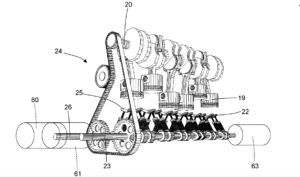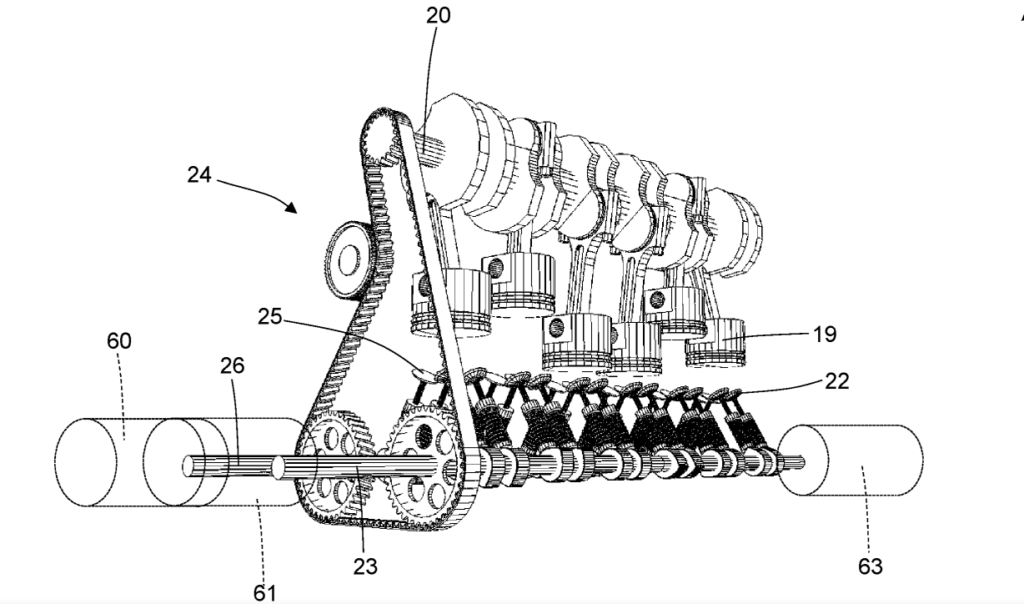
Ferrari patent for upside-down hydrogen engine stirs critical response
By onTechnology
Ferrari has applied for a patent on an upside-down hydrogen-powered internal combustion engine (ICE).
The patent application, published Feb. 29, is for a hybrid vehicle with rear wheels driven by an ICE engine and front wheels by an electric motor. The hydrogen engine sits with the crankshaft at the top and the cylinder head at the bottom.
CarThrottle reports Ferrari has said it is exploring an all-electric vehicle but Ferrari officials have stated combustion-powered vehicles will never cease to exist for the company.
The article continues to say the exploration of hydrogen-powered internal combustion engines and the operation of the rear and front wheels by different power sources isn’t a new concept.
Ferrari’s patent uses an inline-six fueled engine to provide room for the hydrogen tanks on either side, Motor1 says. The article says there’s also some logic behind the engine being placed upside down.
“The transaxle can now be placed higher up on the engine, which means a more aggressive diffuser can be installed at the back of the car,” Motor1 says. “Some World War II fighter aircraft had upside-down engines like this, so it’s not completely unheard of.”
The engine is placed upside down to keep the vehicle shorter, Motor1 says.
Autoguide, which first reported on the patent, questions the filing, claiming that it is “smoke and mirrors.”
“Is Modena really working on a hybrid, twin-charged, I6 hydrogen car with an upside-down engine in it? Probably not,” Autoguide says. “More than likely, the filings are there so that the brand has access to these various patents when it needs them. It makes sense to hold a patent for a supercharged engine, or a turbocharged one, or an inline-six just in case emissions regulations get real tight. But all at once? Not only does it sound like a maintenance nightmare even the most rigid of Ferrari collectors might scoff at, but it sounds downright improbable that Ferrari, a brand highly conscious of its ‘heritage’ and image, would go for something so disruptive.”
The inventor listed on the patent, Fabrizio Favaretto, responded to a tag on LinkedIn to the article with the comment, “Without passion, self-belief and bravery, innovation would simply fail to exist.”
Favaretto added that there are no reference or books to follow for innovation.
“Experience is useful but is not enough,” Favaretto wrote. “You need to use competence and basic physics. Very few basic natural law, but very well understood. You must use them like the musical notes to compose, e.g. you must find the right spatial location of the center of mass (XYZ), higher volumetric mass close to the ground et al. Spatial Mathematization. With the basic physics of hydrogen you must forget everything you know about how to design a car. Talk is cheap.”
Motor Trend also questions if an upside engine would be feasible, saying gravity could cause problems for the oiling system.
“In a conventional wet-sump oiling system, you can count on gravity to help drain oil back down to the oil pan and the pump and circulate it where it needs to go,” the article says. “The crankshaft is also low in a conventional engine, so the oiling path isn’t far from the pump.”
The article says Ferrari attempts to address this with three pumps, one for pressurizing the feed side and two for the recovery side.
“One other issue in an inverted engine is that oil that isn’t scavenged back into the sump can seep down into the cylinders, potentially causing a mechanically disastrous hydrolocking situation,” the article says. “Ferrari doesn’t fully explain how any remaining oil that the recovery pumps can’t pull back before the engine turns off doesn’t hydrolock it. It appears the patent designers expect that these pumps will pull enough out to prevent this longstanding issue for upside-down cylinders.”
Nearly all coverage of the patent application questions the reality of it ever existing in the real world.
IMAGES
Photo from U.S. Patent Application Publication.

